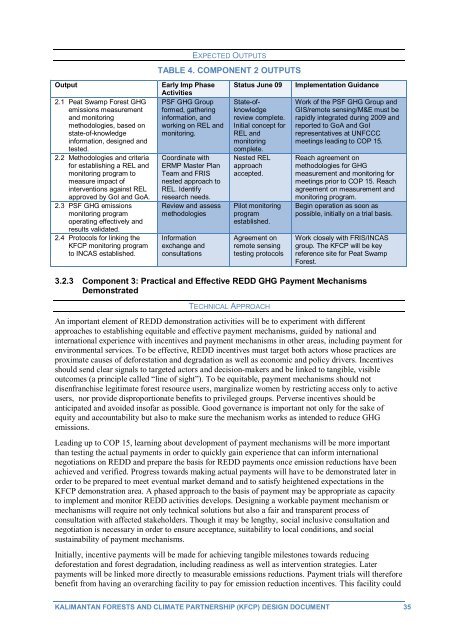Kalimantan Forests and Climate Partnership (KFCP) Design ...
Kalimantan Forests and Climate Partnership (KFCP) Design ...
Kalimantan Forests and Climate Partnership (KFCP) Design ...
You also want an ePaper? Increase the reach of your titles
YUMPU automatically turns print PDFs into web optimized ePapers that Google loves.
EXPECTED OUTPUTS<br />
TABLE 4. COMPONENT 2 OUTPUTS<br />
Output<br />
2.1 Peat Swamp Forest GHG<br />
emissions measurement<br />
<strong>and</strong> monitoring<br />
methodologies, based on<br />
state-of-knowledge<br />
information, designed <strong>and</strong><br />
tested.<br />
2.2 Methodologies <strong>and</strong> criteria<br />
for establishing a REL <strong>and</strong><br />
monitoring program to<br />
measure impact of<br />
interventions against REL<br />
approved by GoI <strong>and</strong> GoA.<br />
2.3 PSF GHG emissions<br />
monitoring program<br />
operating effectively <strong>and</strong><br />
results validated.<br />
2.4 Protocols for linking the<br />
<strong>KFCP</strong> monitoring program<br />
to INCAS established.<br />
Early Imp Phase<br />
Activities<br />
PSF GHG Group<br />
formed, gathering<br />
information, <strong>and</strong><br />
working on REL <strong>and</strong><br />
monitoring.<br />
Coordinate with<br />
ERMP Master Plan<br />
Team <strong>and</strong> FRIS<br />
nested approach to<br />
REL. Identify<br />
research needs.<br />
Review <strong>and</strong> assess<br />
methodologies<br />
Information<br />
exchange <strong>and</strong><br />
consultations<br />
Status June 09<br />
State-ofknowledge<br />
review complete.<br />
Initial concept for<br />
REL <strong>and</strong><br />
monitoring<br />
complete.<br />
Nested REL<br />
approach<br />
accepted.<br />
Pilot monitoring<br />
program<br />
established.<br />
Agreement on<br />
remote sensing<br />
testing protocols<br />
Implementation Guidance<br />
Work of the PSF GHG Group <strong>and</strong><br />
GIS/remote sensing/M&E must be<br />
rapidly integrated during 2009 <strong>and</strong><br />
reported to GoA <strong>and</strong> GoI<br />
representatives at UNFCCC<br />
meetings leading to COP 15.<br />
Reach agreement on<br />
methodologies for GHG<br />
measurement <strong>and</strong> monitoring for<br />
meetings prior to COP 15. Reach<br />
agreement on measurement <strong>and</strong><br />
monitoring program.<br />
Begin operation as soon as<br />
possible, initially on a trial basis.<br />
Work closely with FRIS/INCAS<br />
group. The <strong>KFCP</strong> will be key<br />
reference site for Peat Swamp<br />
Forest.<br />
3.2.3 Component 3: Practical <strong>and</strong> Effective REDD GHG Payment Mechanisms<br />
Demonstrated<br />
TECHNICAL APPROACH<br />
An important element of REDD demonstration activities will be to experiment with different<br />
approaches to establishing equitable <strong>and</strong> effective payment mechanisms, guided by national <strong>and</strong><br />
international experience with incentives <strong>and</strong> payment mechanisms in other areas, including payment for<br />
environmental services. To be effective, REDD incentives must target both actors whose practices are<br />
proximate causes of deforestation <strong>and</strong> degradation as well as economic <strong>and</strong> policy drivers. Incentives<br />
should send clear signals to targeted actors <strong>and</strong> decision-makers <strong>and</strong> be linked to tangible, visible<br />
outcomes (a principle called ―line of sight‖). To be equitable, payment mechanisms should not<br />
disenfranchise legitimate forest resource users, marginalize women by restricting access only to active<br />
users, nor provide disproportionate benefits to privileged groups. Perverse incentives should be<br />
anticipated <strong>and</strong> avoided insofar as possible. Good governance is important not only for the sake of<br />
equity <strong>and</strong> accountability but also to make sure the mechanism works as intended to reduce GHG<br />
emissions.<br />
Leading up to COP 15, learning about development of payment mechanisms will be more important<br />
than testing the actual payments in order to quickly gain experience that can inform international<br />
negotiations on REDD <strong>and</strong> prepare the basis for REDD payments once emission reductions have been<br />
achieved <strong>and</strong> verified. Progress towards making actual payments will have to be demonstrated later in<br />
order to be prepared to meet eventual market dem<strong>and</strong> <strong>and</strong> to satisfy heightened expectations in the<br />
<strong>KFCP</strong> demonstration area. A phased approach to the basis of payment may be appropriate as capacity<br />
to implement <strong>and</strong> monitor REDD activities develops. <strong>Design</strong>ing a workable payment mechanism or<br />
mechanisms will require not only technical solutions but also a fair <strong>and</strong> transparent process of<br />
consultation with affected stakeholders. Though it may be lengthy, social inclusive consultation <strong>and</strong><br />
negotiation is necessary in order to ensure acceptance, suitability to local conditions, <strong>and</strong> social<br />
sustainability of payment mechanisms.<br />
Initially, incentive payments will be made for achieving tangible milestones towards reducing<br />
deforestation <strong>and</strong> forest degradation, including readiness as well as intervention strategies. Later<br />
payments will be linked more directly to measurable emissions reductions. Payment trials will therefore<br />
benefit from having an overarching facility to pay for emission reduction incentives. This facility could<br />
KALIMANTAN FORESTS AND CLIMATE PARTNERSHIP (<strong>KFCP</strong>) DESIGN DOCUMENT 35

















